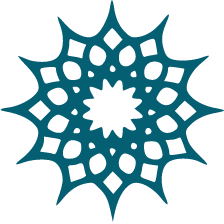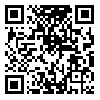المجلد 3، العدد 1 - ( 1443 )
المجلد 3 العدد 1 صفحات 52-78 |
الرجوع إلی قائمة المجلدات
Download citation:
BibTeX | RIS | EndNote | Medlars | ProCite | Reference Manager | RefWorks
Send citation to:



BibTeX | RIS | EndNote | Medlars | ProCite | Reference Manager | RefWorks
Send citation to:
Dudman Kushki A, Bahmani Y. Manifestations of Socialist Romanticism in Rijal fi Al-Shams: A Critical Study. san 2022; 3 (1) :52-78
URL: http://san.khu.ac.ir/article-1-184-ar.html
URL: http://san.khu.ac.ir/article-1-184-ar.html
دودمان کوشکي علی، بهمني یکتا. وصف الأسس الرومانسية الاشتراكية في رواية «رجال في الشّمس». دراسات في السردانية العربية. 1443; 3 (1) :52-78
1- جامعة الرازي ، bolook5@yahoo.com
2- جامعة الرازي
2- جامعة الرازي
الملخّص: (2587 المشاهدة)
تدرس الدراسة الحالیة الرومانسية الاشتراكية في رواية «رجال في الشّمس» للکاتب الفلسطیني الموهوب غسّان کنفاني في مجال الروايات الأدبیة. غالبًا ما يطور المؤلف في هذا الكتاب مفاهيم مثل التعاطف والمقاومة والتضحية بالنفس والنضال وبهذه الطریقة في شكل الرومانسية الاشتراكية ، يشرح حالة المجتمع وينتقد دور الحكومة الفاسدة وعجز الشعب كما يناقش الاضطرابات الاجتماعية وحقوق الطبقة الضعيفة والإمبريالية وصراع التقاليد والحداثة ویصور الجراح والجروح التي ألحقتها الصهيونية العالمية بنسیج الاقتصادی والثقافة المجتمعها بقلم جمیل. من السمات البارزة لهذا النوع أنه من الممكن تحقيق أسلوب المؤلف في السرد و الراوي والخصائص العامة واستخدام اسالیب المؤلف الخاص. لذلك ، في هذه المقالة ، حاول المؤلفون شرح مبادئ الواقعية الاشتراكية في هذه القصة باستخدام ميزات مثل الفعل و فکرة القصة القوية والوقت والمكان والحجم ونوع التعبير السردي وكذلك علاقة السبب والنتيجة بين الظواهر. ومفاهيم مثل التعبير العاطفي عن السرد ، وعدم الرضا عن الوضع الحالي ، والاختفاء في مساحات أخرى ، تعكس مناهضة الاستبداد في هذه القصة أكثر من ذي قبل يُظهر البحث، أن المؤلفين من خلال دراسة أطر الرومانسية الاشتراكية وأيضًا تطبيق أفكار جديدة تتمحور حول الواقعية الاشتراكية ، قد توصلوا إلى استنتاج مفاده أن الأنواع الجديدة قد جعلت تعزيز المستوى الفكري للناس اولویتها ومن ثم ، فإن المحتوى المحدث لمثل هذه القصص يهدف إلى تصميم إنجاز جديد من خلال تفكيك الأنواع السردية القديمة التي لا تلبي احتياجات مجتمع اليوم، من أجل إثراء ثقافة مجتمعه على مستوى العالم. تم تحليل هذه الدراسة بطريقةالمنهج التحلیلی تعتمد على معايير مناسبة للرومانسية الاشتراكية في الأعمال السردية وأيضًا على أساس الاستنتاج الاستقرائي-من الجزء إلى الكل.
قائمة المصادر
1. اخوت، احمد (1992). اعد القصة، أصفهان: نشر فردا.
2. ایبرمز، می¬یر هوراد (2005). المعجم الوصفي للمصطلحات الأدبية، ترجمة سعید سبزیان مراد آبادی، طهران: رهنما.
3. ایرانی، ناصر (1985). قصص وتعريفات وأدوات وعناصر، طهران: مركز التنمية الفكرية للأطفال والمراهقين.
4. ایوب، محمد (2001م). الزمن و السرد القصصی فی روایة الفلسظینیة المعاصرة بین 1973- 1994،دون مکان: دار السند آباد للنشر و التوزیع.
5. برتنس، هانس (2005). مبان أساسيات النظرية الأدبية، ترجمة محمد رضا أبو القاسمي، الطبعة الأولى، طهران: نشر ماهی.
6. پاشایی، محمد، رفیعی، راضیه (2016). دراسة مقارنة للروايات الاجتماعية الأولى لإيران ومصر، دراسات مقارنة فارسية عربية ربع سنوية، المجلد 1، العدد 1، ص 33-57.
7. پاینده، حسین (1389). قصة قصيرة في إيران، المجلد الثاني، طهران: نيلوفر.
8. جعفری جزی، مسعود (1378). دورة الرومانسية في أوروبا، الطبعة الأولى، طهران: الوسط.
9. ﺣﻤﻮد، ﻣﺎﺟﺪه (2005). ﺟﻤﺎﻟﻴﺎت اﻟﺸﺨﺼﻴﺔ اﻟﻔﻠﺴﻄﻴﻨﻴﺔ ﻟﺪي ﻏﺴّﺎن ﻛﻨﻔﺎﻧﻲ، دﻣﺸﻖ: دار اﻟﻨﻤﻴﺮﻟﻠﻄﺒﺎﻋﺔ و اﻟﻨﺸﺮ.
10. خزائل، حسن (2005). ثقافة الأدب العالمي، المجلد السادس، طهران: کلبه.
11. داد، سیما (2011). قاموس المصطلحات الأدبية، الطبعة الخامسة، طهران: مروارید.
12. رضوانیان، قدسیه و نوری، فریده (2009). "الراوي في الرواية بلا دخان"، اللغة الفارسية وبحوث الأدب، كلية الآداب والعلوم الإنسانية، جامعة أصفهان، المجلد الجديد، العدد 4، ص 79-94.
13. رضی، احمد و فائقه عبداللهیان (2010). تحليل العناصر الخيالية في رواية الشطرنج بآلة يوم القيامة، والأدب واللغات: أدب الاستدامة، السنة الثانية، العددان 3 و 4، ص 230-232.
14. سید حسینی، رضا (2008). المدارس الأدبية، المجلد الأول، طهران: نگاه.
15. شمیسا، سیروس (2004). الأنواع الأدبية، طهران: فردوس.
16. ﺻﺎﻟﺢ، ﻧﻀﺎل (2004م). ﻧـﺸﻴﺪ اﻟﺰﻳﺘـﻮن؛ ﻗـﻀﻴﺔ اﻻرض ﻓـﻲاﻟﺮواﻳﺔ اﻟﻌﺮﺑﻴﺔ اﻟﻔﻠﺴﻄﻴﻨﻴﺔ، دﻣﺸﻖ: اﺗﺤﺎد اﻟﻜﺘﺎب اﻟﻌﺮب.
17. عاملی رضایی، مریم (2013). دراسة وتحليل لبنية العلاقات الأسرية في الروايات الاجتماعية في الستينيات، معهد الدراسات الإنسانية والثقافية، السنة الثالثة، عدد 3، ص 27-50.
18. عبدالله، محمدحسن (1989). الريف في التراث العربي، الكويت، عالم المعرفة.
19. عبدی، صلاح الدین، مرادی، مریم (2012). رواية الراوي (دراسة حالة "رجال في الشمس" ) مجلة أدب الاستدامة، المجلد الأول، ص 260-295.
20. فورست، ليليان (2001). الرومانسية، ترجمة مسعود جعفري، طهران: مرکز.
21. فورستر، ادوارد مورگان (1990). جوانب الرواية ترجمة إبراهيم يونسي الطبعة الثانية طهران: نگاه.
22. قبادی، مصیب، (2017) "دراسة مقارنة لروايات "العصفوریه" غازی القصیبی و "اهل غرق" منیر روانی پور"، علی سلیمی، رسالة دكتوراه في اللغة العربية وآدابها، كرمانشاه: جامعة الرازي.
23. ﻛﻨﻔﺎﻧﻲ، غسّان (2012). رﺟﺎل ﻓﻲ اﻟﺸّﻤﺲ، ترجمة إحسان موسوي خلخالي، طهران: نيلوفر.
24. الفارسية وآدابها، المجلد 6، العدد 10، ص 121-144.
25. میرصادقی، جمال و میرصادقی، میمنت (1998). معجم فن الرواية، قاموس مفصل للمصطلحات الروائية، طهران: كتاب مهناز.
26. ـــــــــــ (2009). عناصر القصة، الطبعة السادسة، طهران: سخن.
27. Okhovat, Ahmad (1992). Grammar of fiction, Isfahan: Farda Publishing.
28. Ibermes, Meyer Horad (2005). Descriptive Dictionary of Literary Terms, translated by Saeed Sabzian Moradabadi, Tehran: Rahnama.
29. Irani, Nasser (1985). Fiction, definitions, tools and elements, Tehran: Intellectual Development Center of Children and Teenagers.
30. Ayub, Mohammad (2001). Time and storytelling in the contemporary philosophical novel between 1973- 1994, place: Dar Al-Sindabad for Publishing and Distribution.
31. Bertens, Hans (2005). Fundamentals of Literary Theory, translated by Mohammad Reza Abolghasemi, First edition, Tehran: Mahi Publishing.
32. Pashaei, Mohammad, Rafiei, Razieh (2016). Comparative Study of the First Social Novels of Iran and Egypt, Persian-Arabic Comparative Studies Quarterly, Volume 1, Number 1, pp. 33-57.
33. Payende, Hossein (2010). Short story in Iran, Volume 2, Tehran: Niloufar.
34. Jafari Jazi, Massoud (1999). Path of Romanticism in Europe, First Edition, Tehran: Center.
35. Hammoud, Majda (2005). The Aesthetics of the Palestinian Personality by Ghassan Kanfani, Damascus: Dar Al-Nameer for printing and publishing.
36. Khazael, Hasan (2005). Culture of World Literature, Volume 6, Tehran: Kolbeh.
37. Dad, Sima (2011). Dictionary of Literary Terms, Fifth Edition, Tehran: Morvarid.
38. Rezvanian, Ghodsieh and Nouri, Farideh (2009). "Narrator in the novel of Smokeless Fire", Persian Language and Literature Research, Faculty of Literature and Humanities, University of Isfahan, New Volume, Number 4, pp. 79-94.
39. Razi, Ahmad and Faeqeh Abdullahian (2010). Analysis of fictional elements in the novel of Chess with the Doomsday Machine, Literature and Languages: Defense Literature, Second Year, Nos. 3 and 4, pp. 230-232.
40. Seyed Hosseini, Reza (2008). Literary Schools, Volume 1, Tehran: Negah.
41. Shamisa, Sirus (2004). Literary types, Tehran: Ferdows.
42. Salih, Nizal (2004). Olive anthem; The Land Question in the Palestinian Arab Novel, Damascus: Arab Writers :union:.
43. Ameli Rezaei, Maryam (2013). Study and Analysis of the Structure of Family Relations in Social Novels of the Sixties, Institute of Humanities and Cultural Studies, Third Year, No. 3, pp. 27-50.
44. Abdullah, Mohammad Hassan (1989). Countryside in the Arabic novel, Kuwait, the world of knowledge.
45. Abdi, Salahuddin, Moradi, Maryam (2012). Narrator Function in Narration Method of Defense Novel (the case study of " Men in the Sun " by Ghassan Kanfani), Journal of Defense Literature, Vol. 5 pp. 260-295
46. Forrest, Lillian, (2001). Romanticism, translated by Massoud Jafari, Tehran: Center.
47. Forster, Edward Morgan (1990). Aspects of the novel, translated by Ibrahim Younesi, second edition, Tehran: Negah.
48. Ghobadi, Mosayeb, (2017). "Comparative study of the novels “The bird” by Ghazi Al-Qasebi and “People drowned "by Munir Ravanipour", Ali Salimi, PhD Thesis in Arabic Language and Literature, Kermanshah: Razi University.
49. Kanfani, Ghassan (2012). Men in the Sun, translated by Ehsan Mousavi Khalkhali, Tehran: Niloufar.
50. Mojtaba, Mehdi (2001). New Novelty, Volume One, Tehran: Sokhan Publications.
51. Mahmoudi, Mohammad Ali (2008). Study of Narration in the Blind Owl of Hedayat, Journal of Lyrical Literature in Persian Language and Literature, Volume 6, Number 10, pp. 121-144.
52. Mirsadeghi, Jamal and Mirsadeghi, Meymant (1998). Glossary of the Art of Fiction, Detailed Dictionary of Fiction Terms, Tehran: Mahnaz Book.
53. Mirsadeghi, Jamal and Mirsadeghi, Meymant (2009). Elements of the story, sixth edition, Tehran: Sokhan.
54. Okhovat, Ahmad (1992). Grammar of fiction, Isfahan: Farda Publishing.
55. Ibermes, Meyer Horad (2005). Descriptive Dictionary of Literary Terms, translated by Saeed Sabzian Moradabadi, Tehran: Rahnama.
56. Irani, Nasser (1985). Fiction, definitions, tools and elements, Tehran: Intellectual Development Center of Children and Teenagers.
57. Ayub, Mohammad (2001). Time and storytelling in the contemporary philosophical novel between 1973- 1994, place: Dar Al-Sindabad for Publishing and Distribution.
58. Bertens, Hans (2005). Fundamentals of Literary Theory, translated by Mohammad Reza Abolghasemi, First edition, Tehran: Mahi Publishing.
59. Pashaei, Mohammad, Rafiei, Razieh (2016). Comparative Study of the First Social Novels of Iran and Egypt, Persian-Arabic Comparative Studies Quarterly, Volume 1, Number 1, pp. 33-57.
60. Payende, Hossein (2010). Short story in Iran, Volume 2, Tehran: Niloufar.
61. Jafari Jazi, Massoud (1999). Path of Romanticism in Europe, First Edition, Tehran: Center.
62. Hammoud, Majda (2005). The Aesthetics of the Palestinian Personality by Ghassan Kanfani, Damascus: Dar Al-Nameer for printing and publishing.
63. Khazael, Hasan (2005). Culture of World Literature, Volume 6, Tehran: Kolbeh.
64. Dad, Sima (2011). Dictionary of Literary Terms, Fifth Edition, Tehran: Morvarid.
65. Rezvanian, Ghodsieh and Nouri, Farideh (2009). "Narrator in the novel of Smokeless Fire", Persian Language and Literature Research, Faculty of Literature and Humanities, University of Isfahan, New Volume, Number 4, pp. 79-94.
66. Razi, Ahmad and Faeqeh Abdullahian (2010). Analysis of fictional elements in the novel of Chess with the Doomsday Machine, Literature and Languages: Defense Literature, Second Year, Nos. 3 and 4, pp. 230-232.
67. Seyed Hosseini, Reza (2008). Literary Schools, Volume 1, Tehran: Negah.
68. Shamisa, Sirus (2004). Literary types, Tehran: Ferdows.
69. Salih, Nizal (2004). Olive anthem; The Land Question in the Palestinian Arab Novel, Damascus: Arab Writers :union:.
70. Ameli Rezaei, Maryam (2013). Study and Analysis of the Structure of Family Relations in Social Novels of the Sixties, Institute of Humanities and Cultural Studies, Third Year, No. 3, pp. 27-50.
71. Abdullah, Mohammad Hassan (1989). Countryside in the Arabic novel, Kuwait, the world of knowledge.
72. Abdi, Salahuddin, Moradi, Maryam (2012). Narrator Function in Narration Method of Defense Novel (the case study of " Men in the Sun " by Ghassan Kanfani), Journal of Defense Literature, Vol. 5 pp. 260-295
73. Forrest, Lillian, (2001). Romanticism, translated by Massoud Jafari, Tehran: Center.
74. Forster, Edward Morgan (1990). Aspects of the novel, translated by Ibrahim Younesi, second edition, Tehran: Negah.
75. Ghobadi, Mosayeb, (2017). "Comparative study of the novels “The bird” by Ghazi Al-Qasebi and “People drowned "by Munir Ravanipour", Ali Salimi, PhD Thesis in Arabic Language and Literature, Kermanshah: Razi University.
76. Kanfani, Ghassan (2012). Men in the Sun, translated by Ehsan Mousavi Khalkhali, Tehran: Niloufar.
77. Mojtaba, Mehdi (2001). New Novelty, Volume One, Tehran: Sokhan Publications.
78. Mahmoudi, Mohammad Ali (2008). Study of Narration in the Blind Owl of Hedayat, Journal of Lyrical Literature in Persian Language and Literature, Volume 6, Number 10, pp. 121-144.
79. Mirsadeghi, Jamal and Mirsadeghi, Meymant (1998). Glossary of the Art of Fiction, Detailed Dictionary of Fiction Terms, Tehran: Mahnaz Book.
80. Mirsadeghi, Jamal and Mirsadeghi, Meymant (2009). Elements of the story, sixth edition, Tehran: Sokhan.
إرسال رسالة إلى المؤلف المسؤول
| Rights and permissions | |
 |
This work is licensed under a Creative Commons Attribution-NonCommercial 4.0 International License. |




.png)





